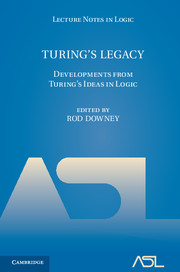Book contents
- Frontmatter
- Contents
- Turing's legacy: developments from Turing's ideas in logic
- Computability and analysis: the legacy of Alan Turing
- Alan Turing and the other theory of computation (expanded)
- Turing in Quantumland
- Computability theory, algorithmic randomness and Turing's anticipation
- Computable model theory
- Towards common-sense reasoning via conditional simulation: legacies of Turing in Artificial Intelligence
- Mathematics in the age of the Turing machine
- Turing and the development of computational complexity
- Turing machines to word problems
- Musings on Turing's Thesis
- Higher generalizations of the Turing Model
- Step by recursive step: Church's analysis of effective calculability
- Turing and the discovery of computability
- Transfinite machine models
- References
Mathematics in the age of the Turing machine
Published online by Cambridge University Press: 05 June 2014
- Frontmatter
- Contents
- Turing's legacy: developments from Turing's ideas in logic
- Computability and analysis: the legacy of Alan Turing
- Alan Turing and the other theory of computation (expanded)
- Turing in Quantumland
- Computability theory, algorithmic randomness and Turing's anticipation
- Computable model theory
- Towards common-sense reasoning via conditional simulation: legacies of Turing in Artificial Intelligence
- Mathematics in the age of the Turing machine
- Turing and the development of computational complexity
- Turing machines to word problems
- Musings on Turing's Thesis
- Higher generalizations of the Turing Model
- Step by recursive step: Church's analysis of effective calculability
- Turing and the discovery of computability
- Transfinite machine models
- References
Summary
“And when it comes to mathematics, you must realize that this is the human mind at the extreme limit of its capacity.”
(H. Robbins)“ … so reduce the use of the brain and calculate!”
(E. W. Dijkstra)“The fact that a brain can do it seems to suggest that the difficulties [of trying with a machine] may not really be so bad as they now seem.”
(A. Turing)§1. Computer calculation.
1.1. A panorama of the status quo. Where stands the mathematical endeavor?
In 2012, many mathematical utilities are reaching consolidation. It is an age of large aggregates and large repositories of mathematics: the arXiv, Math Reviews, and euDML, which promises to aggregate the many European archives such as Zentralblatt Math and Numdam. Sage aggregates dozens of mathematically oriented computer programs under a single Python-scripted front-end.
Book sales in the U.S. have been dropping for the past several years. Instead, online sources such as Wikipedia and Math Overflow are rapidly becoming students' preferred math references. The Polymath blog organizes massive mathematical collaborations. Other blogs organize previously isolated researchers into new fields of research. The slow, methodical deliberations of referees in the old school are giving way; now in a single stroke, Tao blogs, gets feedback, and publishes.
Machine Learning is in its ascendancy. Log Answer and Wolfram Alpha answer our elementary questions about the quantitative world; Watson our Jeopardy questions.
- Type
- Chapter
- Information
- Turing's LegacyDevelopments from Turing's Ideas in Logic, pp. 253 - 298Publisher: Cambridge University PressPrint publication year: 2014
References
- 4
- Cited by

